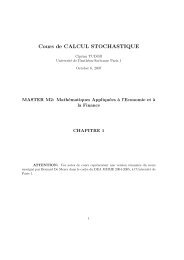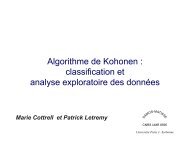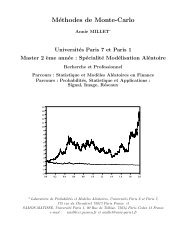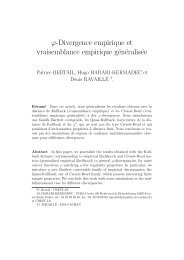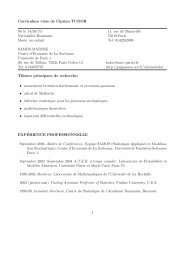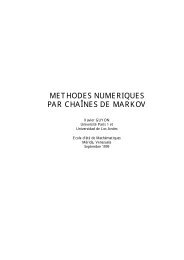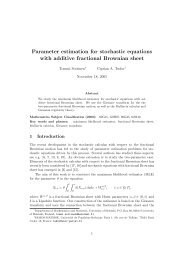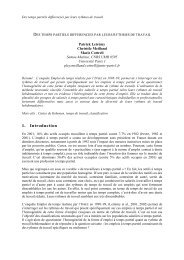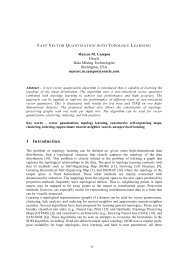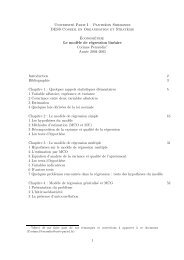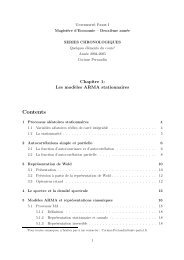An Ant-Based Self-Organizing Feature Maps Algorithm
An Ant-Based Self-Organizing Feature Maps Algorithm
An Ant-Based Self-Organizing Feature Maps Algorithm
Create successful ePaper yourself
Turn your PDF publications into a flip-book with our unique Google optimized e-Paper software.
<strong>An</strong> <strong>An</strong>t-based <strong>Self</strong>-<strong>Organizing</strong> <strong>Feature</strong> <strong>Maps</strong> <strong>Algorithm</strong>τ ( t + 1) (between the cities r and u are updated in terms of the last pheromoner,u)τ ( t) ( r,u), the amountof updating pheromone ∆τ ( t + 1) (and the learning coefficient of local updating ρ. In the formular,u)of ∆τ ( t + 1) (, the term of Q represents the total pheromone capacity of an ant, which is usually setr,u)to be a constant. As all the ants have visited all the cities, only the best tour s will be executed theglobal updating. In other words, the pheromone of other tours will be decreased by the ratio ( 1− α).The development of <strong>An</strong>t Colony Optimization (ACO) meta-heuristic [6], which represents aparticular class of ant algorithms, has become a new research issue within the recent years. Aspointed by the literatures, the ant algorithms have been one of the most successful algorithms ofswarm intelligent system [2], and have been employed to many fields, such as the classical TSP,scheduling, vehicle routing and quadratic assignment problems. With the superior features pointedabove, the ant algorithms have been employed for data mining by more and more researchers. Forinstance, Yuqing et al. [27] proposed a novel K-Means algorithm based on density and antalgorithm, which apply ant-based clustering to create an initial cluster and then K-Means isfollowed. This two-level resolved the problem of local minimum by the multi-point searchingcapability of ant algorithm and enable to handle the sensitivity problem of the initial parameterssettings in K-Means. Besides, Chelokar et al. [3] and Yang et al. [26] recasted the ACO algorithmto meet the requirement for data clustering. Also, Tsai et al.[4] adopted the ACO to decide differentprobability of the next city to be chosen, utilize the simulated annealing concept that decreases thenumber of visit cities, and uses tournament selection strategy to improve the probability functionin ACO. Employed for data mining, the ant algorithms can not long be used for clustering analysisbut data classification. For example, Parpinelli et al. [18] utilized the ACO in the context of rulediscovery to perform a flexible and robust search of the combination of terms involving values ofthe predictor attributes. Wu and Shi [25] employed the Deneubourg’s model for clustering todevelop the Clustering based on Swarm Intelligence (SCI) model through the combination of theswarm similarity, swarm similarity coefficient and probability conversion function.Initialize parameters settingWhile (stop criteria do not meet)Each ant is positioned on a starting nodeWhileApply the state transition rule for each ant to search for a feasible solution and update the pheromonesusing the local updating ruleβ⎧arg max{[ τ ( t)( r,u)] ⋅[η(r,u)]} , if q ≤ q0(exploitation)⎪βs =[ τ ( t)( r,u)] ⋅[η(r,u)],⎨ Pk=, otherwise ( exploration)β⎪ ∑[τ ( t)( r,u)] ⋅[η(r,u)]⎪⎩u∈Jk ( r)⎧ Q⎪ , if u = s∆τ( t + 1)( r,u)= ⎨η(r,u)otherwise⎪⎩ 0,τ t + 1) = (1 − ρ)τ ( t)+ ρ ⋅ ∆τ( t + 1(( r,u)( r,u))(r,u)EndUpdate the pheromone of the best solution using the global updating ruleτ t + 1) = (1 −α)τ ( t)+ α ⋅ ∆τ( t + 1End(( r,s)( r,s))(r,s)Fig. 1 The main portion of the ACS algorithm (reorganized from Dorigo, 1997)
WSOM 2005, Paris2.2 <strong>Self</strong>-<strong>Organizing</strong> <strong>Feature</strong> MapSOM was first introduced by T. Kohonen in 1981 [10,12-15]. It is an unsupervised neuralnetwork method which has the properties of both vector quantization and vector projectionalgorithms. It can be used for various applications such as pattern recognition, biological modeling,data compression, signal processing and data mining [13,23]. SOM is an orderly mappingtechnique which enables to map a high-dimensional data distribution in the input space onto aregular low-dimensional grid structure, usually one or two dimensional. The benefit of SOM is thatit can create a set of prototype vectors which are the most suitable to represent the input datavectors. Generally speaking, it is capable of converting the complex, non-linear and highdimensionaldata into simple, geometric and low-dimensional data which people can easilyvisualize. Therefore, SOM is especially suitable for data exploration in data mining [14,15].As the modifications had been proposed, the SOM family owns a number of variants. Thecategory of most SOM variants can be classified in terms of the following two factors: prototypevector and neighborhood relations [23]. Kangas et al. [9] utilized dynamic weighting of the inputsignals at each input cell which improves the ordering when very different input signals are used.Beside, the concept of Minimal Spanning Tree was also used in their approach to define theneighborhood in the learning algorithm. When compared with the hierarchical clustering methods,the SOM is additionally able to identify the tendency of classification errors when empirical datadifferentiate from the ideal conditions of the isolated clusters [16]. In Vesanto andAlhoniemi(2000) , a two-stage algorithm was proposed. The data input set was first clustered usingthe SOM at the first stage, and then the SOM is clustered to overcome the dilemma as result issimilar to the original data after using the SOM. [22].In this research, we propose an algorithm named <strong>An</strong>t-<strong>Based</strong> <strong>Self</strong>-<strong>Organizing</strong> feature <strong>Maps</strong>(ABSOM) algorithm for data clustering. The ABSOM algorithm owns the original capability ofSOM and two essential features from the ant algorithm: (a) the memorization of the historicalwinning output units by means of the pheromone mechanism of the ACO, (b) the appropriate statetransition accoridng to the exploitation and exploration rules to determine the best matching outputunit on the map topology, instead of using the shortest Euclidean distance.3 MethodologyIn this section, network structure, the mathematical terms and initial parameters of the proposedABSOM are first of all defined and described in the following.3.1 Terminological Definitions(a) Topological network settingDefine the topological network M = {c 1 , c 2 … c j … c m }, in which M consists of m = m 1 × m2 mapunits where m 1 and m 2 represent respectively the number of units located on the two sides of thenetwork. According to the probability distribution P (ξ ) where ξ stands for an input data, the n-ndimensional weight vector wcj∈ R of every map unit c is initialized. Set the start time t = 0 and thejinitial neighborhood radiusλ 0.(b) Pheromone matrix settingConstruct a pheromone matrix T = { τc, τ ,..., ,..., }1 cτ2 c jτ and give each element of the matrix ancminitial pheromoneτ 0= 0 . Define q0to be the pheromone threshold of choosing the exploitation orexploration pheromone rule. The value of q0 is ranged within [0, 1].
<strong>An</strong> <strong>An</strong>t-based <strong>Self</strong>-<strong>Organizing</strong> <strong>Feature</strong> <strong>Maps</strong> <strong>Algorithm</strong>(c) Other parameters settingN ,dlen N , represent the number of total data samples and total training epochs,trainlenrespectively. D is defined to be the set of data samples mapped on the map unitc jc .j3.2 The ABSOM <strong>Algorithm</strong>The detailed steps of the proposed ABSOM algorithm, shown in Fig. 2, can be described asfollows:Step1:Read in and normalize the training data set.Step2:Compute all the neighborhood radii that will be used during the training processes.Step3:Select a sample randomly and calculate the accumulative Euclidean distance δjiandpheromone T between the map units ϖ on the topological network and the input vectorξ ji .N batch munits dim∑∑∑∆δ ( t)= ξ −ϖ( t)(1)c jjii=1c jjkikc jjkτ ( t + 1) = τ ( t)+ ∆δ( t)(2)Step4: Conduct the updating processes for the weight vectors(a) After the set of data samples mapped on the map units, find out the Best Match Unit(BMU) s for each data sample according to the following formula based on the exploitationand exploration updating rules of the ant-based algorithm:⎧arg min ∆δji( t),if q ≤ q0(exploitation)⎪τ ( t + 1)c js = ⎨ pc=, otherwise (exploration)j c j⎪+⎪∑ = cNτc( t 1)j⎩c j = c1(3)where q : a real number generated randomly from 0 to 1;q : the threshold to choose the exploitation updating rule when q is no greater than0q ;0pc j: the probability that the map unit cjto be the BMU when the exploration rule ischosen.To record the data samples that have mapped on the unitexpressed as⎪⎧ { Dc( t),ξ c = sj i},ifjDc( t + 1) = ⎨j⎪⎩{ Dc( t)},otherwisej(b) Calculate the distance between s andcjcj, the accumulated data set can be(c) Update the pheromone for each map unit⎪⎧ βτc( t)+ α∆τ( t + 1), if c = sjc jjτc( t + 1) = ⎨j⎪⎩βTc( t),otherwisej(5)where α: the accumulating rate of pheromone from the Euclidean distance; β: the decayrate of pheromone.(d) Update the weight vector for each map unit(4)
<strong>An</strong> <strong>An</strong>t-based <strong>Self</strong>-<strong>Organizing</strong> <strong>Feature</strong> <strong>Maps</strong> <strong>Algorithm</strong>From the larger data sets III and IV, however, the ABSOM has all lower values of the QEbut higher values of the TE. Although the performances of the two algorithms on QE andTE are not identical, we found the ABSOM always has better DB index value no matterwhat is the size of the data sets. As we know, the QE index is more representative than theTE index to indicate the final result of a clustering analysis method. In addition, we foundthat the ABSOM on the performance of the QE indices as well as the concentration on themap topologies are all better than the SOM. The results can be explained because of theexploration strategy of the state transition rule. The ABSOM has the ability to jump outfrom local minima and find a better solution. For the aspect of TE index, it seemsreasonable that the ABSOM with the capability of jumping out the local minima mayselect a map unit far away from the one which has the shortest distance with the inputvector at the beginning, so that it gets different BMU and worsen the TE value in the twolarger data sets if comparing with the conventional SOM.To investigate the benefit of the ABSOM, the further examination techniques, U-matrixand block diagram of map topology, are conducted for both the algorithms. The U-matrixcan facilitate the identification of the boundaries for different clusters; the block diagramof map topology shows the number of data mapped on each output unit which can alsoease the identification of different clusters and their centers. In the block diagram method,since the size and color of a block respectively represent the number of data mapped on thecorresponding map unit and the cluster belonged, the bigger size of blocks stands for thelarger number of data mapped on the corresponding map units. Using the previous fourdata sets with the given solutions, the ABSOM and SOM obtain the final results shown onthe network topology by the U-matrix method and the block diagram method.As shown in Fig. 2, the map topologies from the SOM and ABSOM are all quite different. Forexample, the data distribution of each cluster sometimes is quite different from these twoalgorithms. Taking the iris data set for example, the first cluster (represented by red color) formedby the SOM is located on the lower part of the map in Fig. 2, but the first cluster formed by theABSOM is located on the right bottom corner of the map. If we show the results from the U-matrixand the block diagram on a map topology, it seems much clear that the ABSOM can get a differentand better solution under the same initial weight vectors.Fig. 2 Visualization of Map topology from the SOM (left)/ABSOM (right) for Iris data set
WSOM 2005, Paris5 Conclusion and Future WorkIn summary, this research has proposed an new algorithm named the ABSOM, that combinesthe ant colony system with the Kohonen’s SOM, to overcome the local minimal issue on theKohonen’s self-organizing maps. In this research, We compared the ABSOM with the conventionalSOM using four data sets with the given solutions and finally we found out the ABSOM is superiorto the conventional SOM in general.As pointed by recent researches, the fixed structure of the conventional SOMs can not afford torespond the real data distribution if the original data set consists of vague boudaries of differentclusters. Therefore, our research work will extend the proposed ABSOM approach to create agrowable ant-based SOM for solving this kind of problem.References[1] E. Bonabeau, M. Dorigo and G. Théraulaz(1999a), From natural to artificial swarmintelligence, Oxford University Press.[2] E. Bonabeau, M. Dorigo, and G. Theraulaz(1999b), Swarm Intelligence: From Natural toArtificial Systems, Oxford University Press, New York.[3] P. S. Chelokar, V. K. Jayaraman, B. D. Kulkarni(2003), <strong>An</strong> <strong>An</strong>t Colony Approach forClustering, <strong>An</strong>alytica Chimica Acta 509(2004), p. 187-195.[4] A. Colorni, M. Dorigo, and V. Maniezzo(1991), Distributed Optimization by <strong>An</strong>t Colonies,Proceedings of ECAL91-European Conference on Artificial Life, Paris, France, F. Varela andP. Bourgine(Eds), Elsevier Publishing, p. 134-142.[5] A. Colorni, M. Dorigo, and V. Maniezzo(1992), <strong>An</strong> Investigation of Some Properties of an <strong>An</strong>t<strong>Algorithm</strong>, Proceedings of the Parallel Problem Solving from Nature Conference(PPSN 92).[6] M. Dorigo(1992), Optimization, Learning and Natural <strong>Algorithm</strong>s, Ph.D Thesis, Dipartimentodi Elettronica e Informazione, Politecnico di Milano, Italia.[7] M. Dorigo, L. M. Gambardella(1997), <strong>An</strong>t Colony System: A Cooperative Learning Approachto the Traveling Salesman Problem, IEEE transactions on Evolutionary Computation, vol.1,No.1.[8] M. Dorigo, V. Maniezzo and A. Colorni(1996), The <strong>An</strong>t System:Optimization by a Colony ofCooperaing Agents, IEEE Transactions on Systems.[9] J. A, Kangas, T. Kohonen and J. T. Laaksonen(1990), Variants of <strong>Self</strong>-<strong>Organizing</strong> <strong>Maps</strong>, IEEETransactions on Neural Networks, vol. 1, No. 1, March.[10] S. Kasko, J. Kangas, T. Kohonen(1998), Bibliography of <strong>Self</strong>-Grganizing Map (SOM) Papers:1981-1997, Neural Computing Survey 1, p. 102-350.[11] K. Kiviluoto(1996), Topology Preservation in <strong>Self</strong>-<strong>Organizing</strong> <strong>Maps</strong>, In the Proceedings ofInternational Conference on Neural Networks (ICNN), p. 294-299.[12] T. Kohonen(1995), <strong>Self</strong>-<strong>Organizing</strong> Map, 2nd ed., Springer-Verlag, Berlin, p. 113.[13] T. Kohonen(1998), The <strong>Self</strong>-<strong>Organizing</strong> Map, Neurocomputing, vol 21, p. 1-6,[14] T. Kohonen(2000), <strong>Self</strong>-<strong>Organizing</strong> <strong>Maps</strong>, Springer-Verlag.[15] T. Kohonen, <strong>Self</strong>-<strong>Organizing</strong> <strong>Maps</strong>, Springer-Verlag , Berlin, Germany, 1997[16] P. Mangiameli, S. K. Chen, D. West(1996), A Comparison of SOM Neural Network andHierarchical Clustering Methods, European Journal of Operation Research, vol. 93, p. 402-417.[17] V. Maniezzo, A. Colorni, and M. Dorigo(1994), The <strong>An</strong>t System Applied to the QuadraticAssignment Problem, Tech. Rep. IRIDIA/94-28, Universite Libre de Bruxelles, Belgium.[18] R. S. Parpinelli, H. S. Lpoes, and A. A. Freitas(2002), Data Mining With an <strong>An</strong>t ColonyOptimization <strong>Algorithm</strong>, IEEE Transactions on Evolutionary Computing, vol 6, No. 4,August.
<strong>An</strong> <strong>An</strong>t-based <strong>Self</strong>-<strong>Organizing</strong> <strong>Feature</strong> <strong>Maps</strong> <strong>Algorithm</strong>[19] G. Reinelt(1994), The Traveling Salesman: Computational Solutions for TSP Applications,Springer-Berlag.[20] C. F. Tsai, C. W. Tsai, H. S. Wu and T. Yang(2004), ACODF: A Novel Data ClusteringApproach for Data Mining in Large Databases, Journal of Systems and Software, vol. 73, p.133-145.[21] UCI Machine Learning Repository ,http://www.ics.uci.edu/~mlearn/MLRepository.html[22] J. Vesanto and E. Alhoniemi(2000), Clustering of the <strong>Self</strong>-<strong>Organizing</strong> <strong>Maps</strong>, IEEETransictions on Neural Networks, vol.11, No. 3, p. 586-600.[23] J. Vesanto(2000), Using SOM in Data Mining, Department of Computer Science andEngineering of Helsinki University of Technology, Licentiate’s Thesis.[24] J. Vesanto, J. Himberg, E. Alhoniemi, and J. Parhankangas(2000), SOM Toolbox for Matlab 5,Helsinki University of Technology, http://www.cis.hut.fi/projects/somtoolbox.[25] B. Wu and Z. Shi (2001), A Clustering <strong>Algorithm</strong> <strong>Based</strong> on Swarm Intelligence, IEEEInternational Conference on Info-tech & Info-net Proceeding, p.58-66, Beijing, China.[26] X. B. Yang, J. G. Sun and D. Huang(2002), A New Clustering Method <strong>Based</strong> on <strong>An</strong>t Colony<strong>Algorithm</strong>, Proceedings of the 4th World congress on Intellighent Control and Automation,June, p. 10-14, Shanghai, China.[27] P. Yuqing, H. Xiangdan and L. Shang(2003), The K-Means Clustering <strong>Algorithm</strong> <strong>Based</strong> onDensity and <strong>An</strong>t Clolny, IEEE Int. Neural Networks & Signal Processing, p.14-17, Nanjing,China, December.
WSOM 2005, Paris



